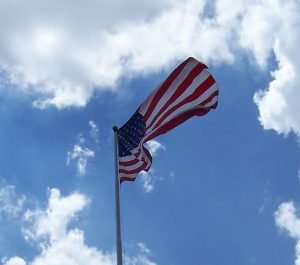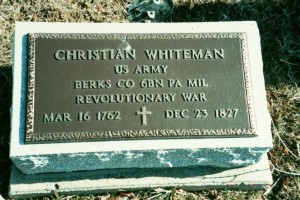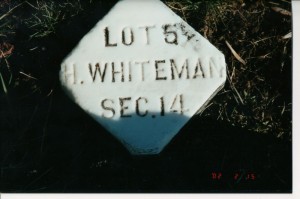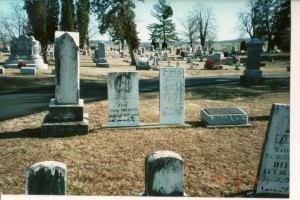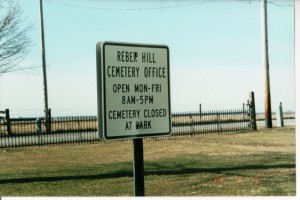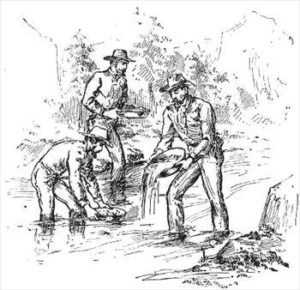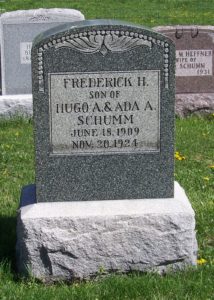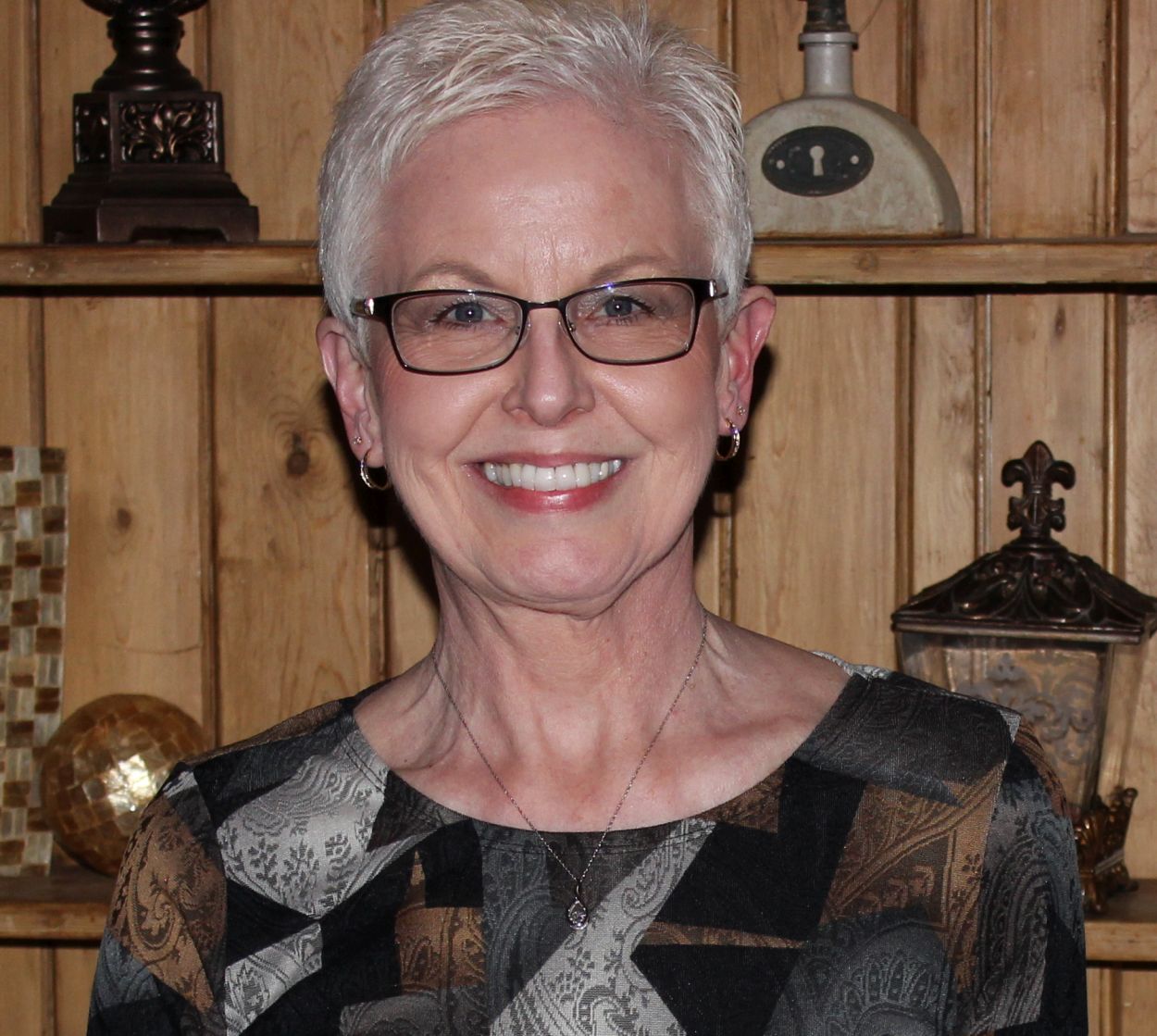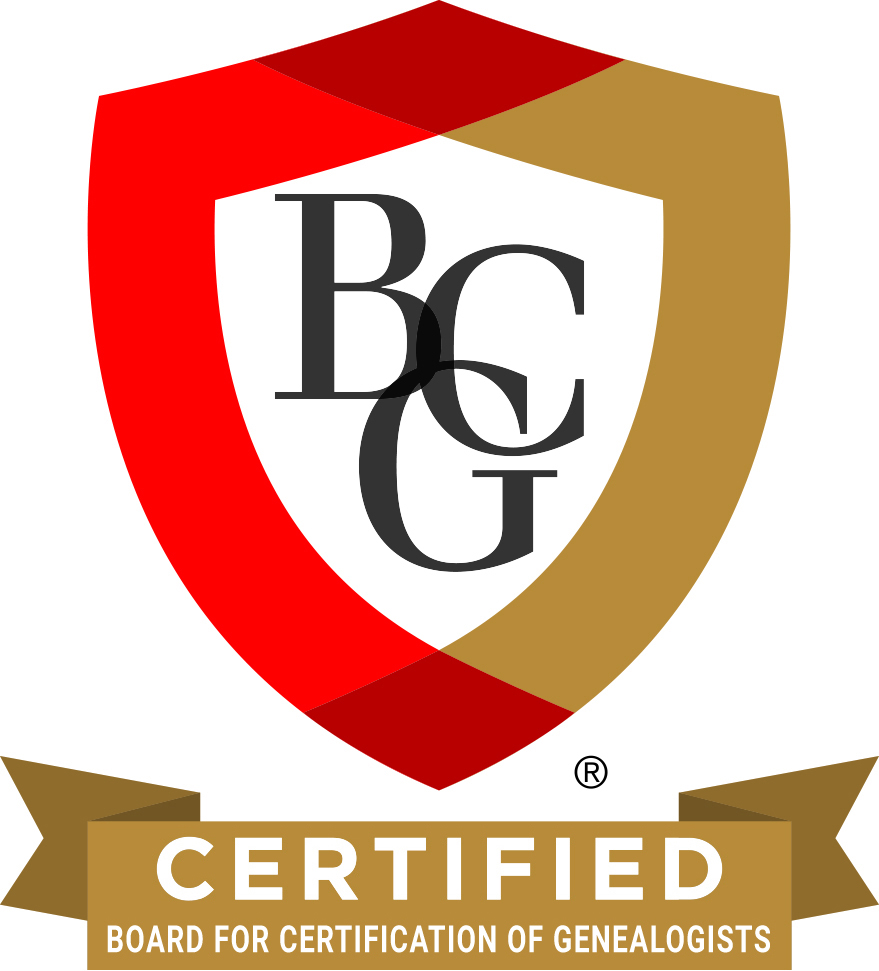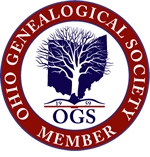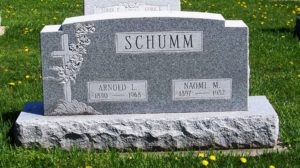
Arnold L & Naomi M (Schumm) Schumm, Zion Lutheran Cemetery, Van Wert County, Ohio. (2012 photo by Karen)
This is the tombstone of Arnold L. and Naomi (Schumm) Schumm, located in row 7 of Zion Lutheran Cemetery, Schumm, Van Wert County, Ohio. The marker is inscribed:
SCHUMM
Arnold L.
1890-1968
Naomi M.
1897-1982
Arnold Ludwig Schumm was born 7 August 1890, the son of John Christian Schumm and Wilhelmine “Minnie” Breuninger. He was baptized at Zion Schumm on 17 August 1890, with Henry Schumm II and Wilhelm Buchner II serving as his sponsors.
Arnold’s mother Minnie (Breuninger) Schumm died in 1899.
Arnold Schumm, age 10, with his family in 1900: John Schumm, 50; Victor A, 18; Hilda M, 16; Lydia, 16; Elizabeth, 12; Arnold, 10; Salome, 7; and Otis, 23. His father John Schumm was a farmer. [1]
The John Schumm family in 1910: John, 60; Hilda, 26; Lydia, 26; Arnold, 19; and Salome, 17. [2]
The John Schumm family in 1920: John, 70; Arnold, 28; and Salome, 25. [3]
Arnold Schumm married Naomi Schumm on 16 November 1922 at the home of Naomi’s parents in Black Creek Township, Mercer County, Ohio. Rev. Bienert officiated and Amos Schumm and Salome Schumm were witnesses to their marriage.
Naomi Margaretha Schumm was the daughter of Fredrick Jr and Mary (Buchner) Schumm and was born 2 March 1897. She was the fifth and last child born to Friedrick and Mary Schumm. Her mother Mary (Buchner) was the second wife of Frederick Jr and Naomi had six living step-siblings when she was born.
Naomi Schumm was baptized at home on 14 March 1897, with Mrs. Heinrich Buchner and Barbara Schumm serving as her sponsors.
Naomi Schumm, with her family in 1900, on the family’s farm in Mercer County: Friedrich Schumm, 56; Mary, 39; Hugo, 24; Leona, 22; Henrietta, 20; Lawrence, 15; Amos, 8; Erna, 5; and Naomi, 3. [4]
Naomi‘s father Frederick Schumm Jr died 24 December 1907.
In 1910 Naomi lived with her widowed mother Mary (Buchner) Schumm and Naomi’s siblings: Mary Schumm, 49; William, 25; Amos, 18; Erna, 15; and Naomi, 12. [5]
Naomi lived with her brother Amos and his family in 1920. Their mother Mary (Buchner) Schumm also lived with them: Amos, 28; Esther, 26; Ruth, 0; Naomi, 22; and Mary, 58. [6]
In 1926, four years after their marriage, Naomi gave birth to twins, a boy and girl, but they died the same day or were stillborn. A daughter, Lois, was born in 1928.
Naomi’s mother Mary (Buchner) Schumm died 16 February 1930.
The Arnold Schumm family in 1930: Arnold, 39; Naomi, 32; and Lois, 1. [7]
Arnold and Naomi had two more children in the next ten years. Frederick was born in 1933 and Wilma in 1936.
The Arnold Schumm family in 1940: Arnold, 49; Naomi, 43; Lois, 11; Frederick, 6; and Wilma, 3. Arnold was a farmer. [8]
Arnold Schumm died at Lutheran Hospital in Fort Wayne, Indiana, on 29 March 1968. He died from an aneurysm and atherosclerosis and was buried on 1 April. [9]
His widow Naomi (Schumm) Schumm died in Van Wert County on 26 January 1982.
Arnold and Naomi (Schumm) Schumm had the following children:
Twins, male & female (1926-1926)
Lois M (1928-2002)
Frederick J (1933-2015), married Eileen Saalfrank
Wilma Louise (1936-2020), married Paul Frederick Schmidt
[1] 1900 U.S. Census, Willshire, Van Wert, Ohio, ED 98, p.11, dwelling 216, family 221, John Schumm; digital image by subscription, Ancestry.com (https://www.ancestry.com/search/collections/7602/ : viewed 28 Jun 2020).
[2] 1910 U.S. Census, Willshire, Van Wert, Ohio, ED 114, p.6A, dwelling 111, family 112, John G Schumm; digital image by subscription, Ancestry.com (https://www.ancestry.com/search/collections/7884/ : viewed 28 Jun 2020).
[3] 1920 U.S. Census, Willshire, Van Wert, Ohio, ED 146, p.2B, dwelling & family 42, John C Schumm; digital image by subscription, Ancestry.com (https://www.ancestry.com/search/collections/6061/ : viewed 28 Jun 2020).
[4] 1900 U.S. Census, Black Creek, Mercer, Ohio, ED 74, p.2, dwelling & family 29, Frederick Schumm; digital image by subscription, Ancestry.com (https://www.ancestry.com/search/collections/7602/ : viewed 17 May 2020).
[5] 1910 U.S. Census, Black Creek, Mercer, Ohio, ED 107, p.2A, dwelling & family 26, Marry Schwinn; digital image by subscription, Ancestry.com (https://www.ancestry.com/search/collections/7884/ : viewed 17 May 2020).
[6] 1920 U.S. Census, Black Creek, Mercer, Ohio, ED 124, p.1B, dwelling & family 15, Amos Schumm; digital image by subscription, Ancestry.com (https://www.ancestry.com/search/collections/6061/ : viewed 28 Jun 2020).
[7] 1930 U.S. Census, Willshire, Van Wert, Ohio, ED, p. dwelling 95, house, 97, Arnold Schuman; digital image by subscription, Ancestry.com (https://www.ancestry.com/search/collections/6224/ : viewed 28 Jun 2020).
[8] 1940 U.S. Census, Willshire, Van Wert, Ohio, ED 81-28, p.5A, house visited 41, Arnold Schumm; Schumm; digital image by subscription, Ancestry.com (https://www.ancestry.com/search/collections/2442/ : viewed 28 Jun 2020).
[9] Indiana Death Certificates, 1899-2011, 1968, roll 5, Arnold Louis Schumm death certificate, 29 Mar 1968; digital image by subscription, Ancestry.com, viewed 28 Jun 2020.

